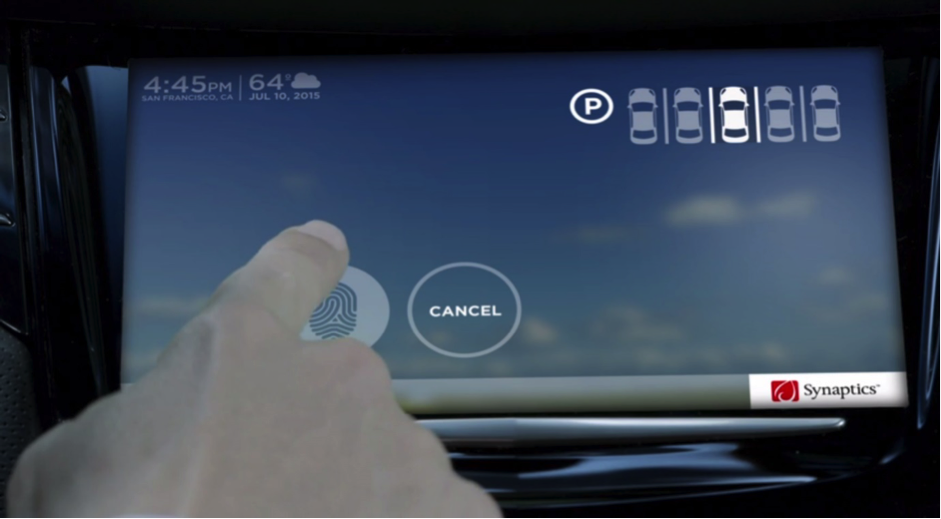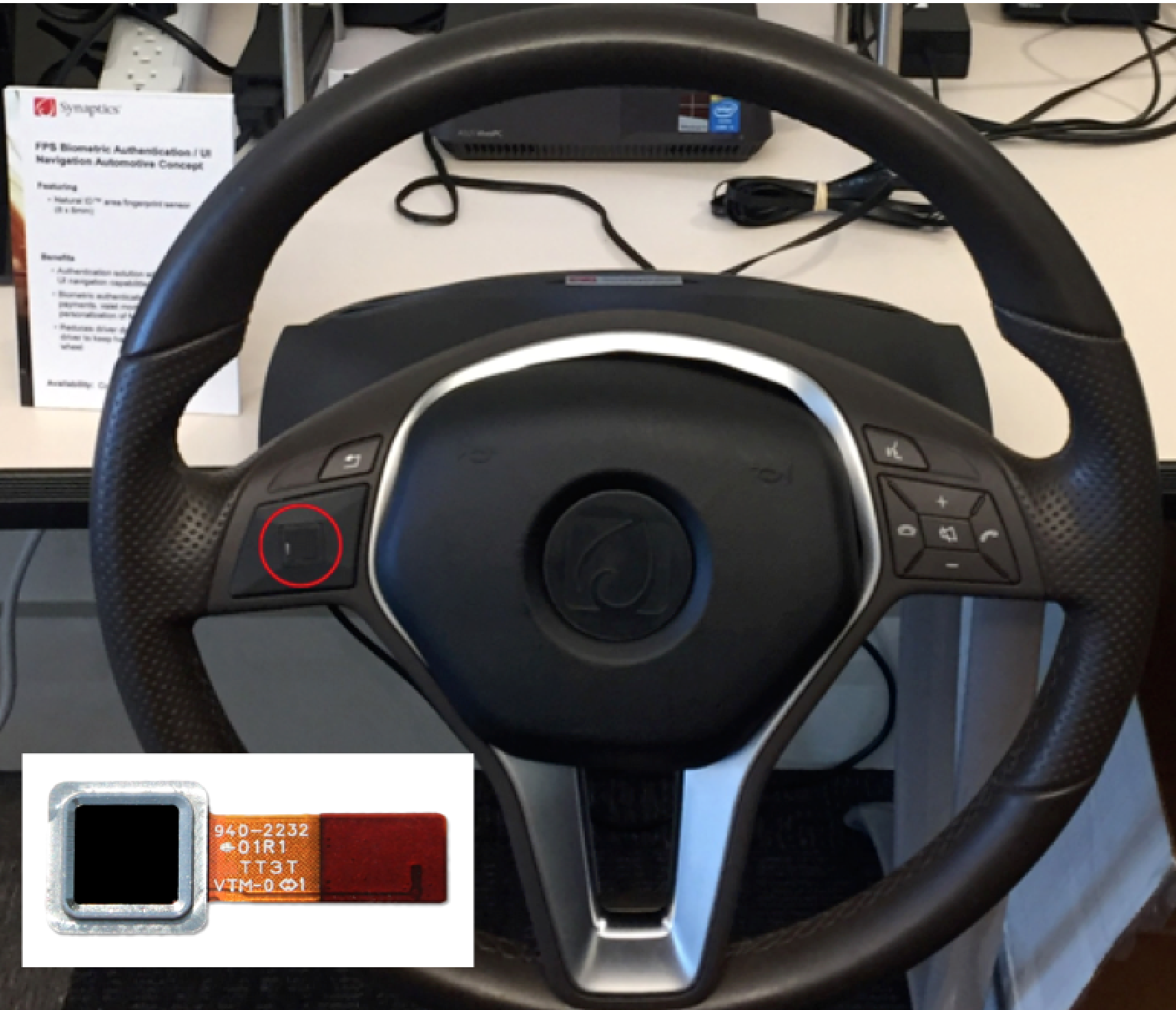BY RAJA BOSE, Scientist and Research Technologist
Synaptics
www.synaptics.com
Automotive engineers continue to look to the smartphone to provide a model for the development of an increasingly sophisticated user experience, with the large center information display (CID) capacitive touchscreen being a good example. Now designers are adding another smartphone feature, the fingerprint sensor, to enhance and modernize the driver’s interface to functions in and beyond the automobile.
This, and other forms of biometric authentication, show great promise if implemented with sensitivity to user privacy and the extremes of the automotive operating environment. However, developers must factor in that the use cases of biometric authentication in the car look set to differ, perhaps surprisingly, from those of the smartphone.
Personalizing the user experience
The obvious assumption about fingerprint sensing in the car is that it should be used as a convenient and secure replacement for the key — both for providing access to the cabin and for starting the engine. However, fingerprint sensing is an unsatisfactory form of security in vehicles for two reasons.
The first is convenience tied to usage model. A car may be driven by someone other than its registered owner in emergencies or when using a valet service. A fingerprint sensor, then, can never entirely replace a key.
The second is security. Fingerprint sensors have a “false acceptance rate” specification as they occasionally accept a stranger’s fingerprint as that of the registered user. This is not acceptable to automobile manufacturers, so conventional wireless keys are not about to be superseded by fingerprint sensors on the door handle or start button.
However, fingerprint sensing does enable two far-reaching improvements to the user experience: personalization and payment authentication. The fingerprint sensor can quickly identify who is driving and configure user preferences accordingly, including seat, climate, and entertainment settings.
While personalization enhances the user experience, it also helps drivers take advantage of a car’s sophisticated features and functions, many of which, in today’s cars, are hidden behind multi-layered menu structures and complex sets of commands. Research has shown that for every step added to a user interface, 10% of the users drop out. Personalization via a fingerprint sensor reduces the number of steps to one or even none.
In-car fingerprint sensors can also simplify payments inside the car; for instance, when paying road tolls and parking fees or to charge a payment card at a drive-through store. At a parking garage, for example, a number-plate recognition system would automatically identify the car, and a payment backend would link the car to a pre-registered payment card (Fig. 1) .
The payment terminal would then send a payment authorization request wirelessly to the car. The driver would then authenticate use of the payment card with a fingerprint.
Standards such as the UAF specification published by the FIDO Alliance (fidoalliance.org ) define processes for acknowledging biometric indicators such as fingerprints as an alternative to passwords or PINs. Authentication by fingerprint is a far quicker and easier operation than leaning through the driver’s door window to insert a card into a reader and then enter a PIN on a keypad.

Fig. 1: Fingerprint sensing provides a quick and convenient way for the driver to authenticate a payment.
Biometric indicator options
Along with fingerprint sensors, other forms of biometric sensing under consideration by automotive designers include facial recognition, iris recognition, and heart-rate variability (i.e., taken from a wireless health-monitoring wristband). There is also some interest in the potential to combine biometric indicators — such as heart rate, blood pressure, and perspiration — to determine the driver’s state of health and state of mind. This might allow the car to issue an alert to the driver, for instance, to park the car and rest if the indicators suggest that the driver is drowsy or otherwise at risk. With the advent of advanced driver assistance systems (ADAS), the car may even take control from the driver and park itself in a safe place.
In the meantime, the preferred biometric indicator is the fingerprint as its operation is well understood by users and because the technology has already been proven in smartphones.
Choosing the optimal fingerprint sensor
When choosing a fingerprint sensor, the factors to consider include overall solution size and power consumption, reliability, accuracy, and range, such as in 3D applications. With this in mind, there are three mainstream fingerprint-sensing technologies available for automotive applications:
- Capacitive sensing: This is used in the world’s best-selling smartphones due to small size — a sensing pad just a few tens of microns thick and a small controller IC — and low power consumption. Note, however, that there are a small number of instances when capacitive fingerprint sensing might fail due to “dry finger” problems or when the user has severe scarring or calluses.
- Optical fingerprint sensing: Optical sensors are highly reliable and accurate, and so they are widely used at border crossings. However, the sensors require a backlight to illuminate the finger and are still comparatively bulky compared to capacitive solutions.
- Ultrasonic sensing: This offers reliable detection of fingerprints in 3D but has not found its way into mainstream mobile devices and is a relatively expensive and unproven option.
Another consideration is design flexibility: It’s important to ensure that the sensor can be included without adding surface space or cluttering the cabin. From this perspective, the same benefits of capacitive fingerprint sensing that appealed to smartphone designers appeal equally to automotive designers. A capacitive sensor’s ultra-thin sensing pad gives designers more freedom with regard to styling, shape, and configuration of the sensor unit to suit the form and functions of the cabin (Fig. 2 ).
Along with saving space, this particular design allows the fingerprint sensor to be used with both the driver’s hands on the steering wheel. In the demonstration, the fingerprint sensor was combined with a force sensor so that an authentication event may be triggered only when the pad is deliberately pressed. This avoids accidental authentication while hands are resting on the wheel.

Fig. 2: In a working steering-wheel demonstration (circled in red), the capacitive fingerprint sensor (inset) also doubles as a directional pad (D-Pad) for navigating the in-car user interface.
Requirements for a successful implementation
There are three elements to a successful fingerprint-sensing implementation: the mechanical design of the sensing pad, the sensitivity of the controller IC, and the algorithms running on the IC for accepting or rejecting fingerprints.
The sensing controller IC and the software require specific domain expertise, so automotive system and subsystem designers should consider sourcing the technology from third-party suppliers instead of designing from scratch. Look for a supplier that has a proven track record, particularly in smartphones, in which high volumes and reliability are critical.
The mechanical design — the area and thickness of the sensing pad, the material it is made of, and its positioning in the vehicle — will be decided by the car manufacturer. However, OEMs can leverage a third-party fingerprint-sensor supplier’s experimentation with many different configurations of the sensing pad for smartphone customers.
That said, the differences between consumer and automotive operating requirements are significant. For example, while a smartphone is typically upgraded every 24 months or so, cars can remain in operation for 10 to 12 years before replacement. This means that the fingerprint sensor, the material covering the sensor, and the MCU all have to operate reliably and look cosmetically appealing for a much longer period of time.
This is particularly challenging in an automotive environment that requires components to support extreme operating temperatures (–40°C to 85°C); be resistant to humidity, dust, sunlight, liquids and other environmental factors; and offer more robust resistance to ESD and RF interference.
To ensure reliability, designers should make sure that components adhere to automotive engineering standards like the ISO 11452 standard for automotive electromagnetic compatibility (EMC) and the Automotive Electronics Council (AEC-Q100) specification for use in harsh automotive environments.
Because they are used to protect access to sensitive information, fingerprint sensors will be attractive targets for hackers using a counterfeit fingerprint to gain access. This will require fingerprint systems to receive regular security software updates once the car leaves the factory, and future generations of a particular car model may also need to upgrade their fingerprint-sensor solution’s processing and storage capabilities to keep pace with more complex anti-spoofing software.
As such, automotive designers and OEMs should look for fingerprint-sensor solutions from vendors with a roadmap for MCU support that allows for pin and software compatibility between MCU generations. It is also recommended that OEMs source their components from vendors with a solid track record for long-term product support.
Conclusion
As a proven technology, then, the capacitive method is set to be the first technology for fingerprint sensing to be adopted in the car. However, for a successful implementation, designers must be aware of the usage models and privacy concerns as well as the criteria under which to select a fingerprint-sensing option.
Time will tell whether it turns out to be preferred by the automotive industry in the longer-term, and there is no doubt that optical, ultrasonic, and other technologies will be evaluated and other forms of biometric sensing may be introduced.
In the meantime, capacitive fingerprint sensing is both liked and understood by users of smartphones, and it provides a ready-made way for automotive designers to make the user experience more convenient, more personal, and more secure.
Advertisement
Learn more about Synaptics





